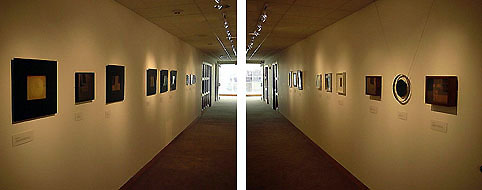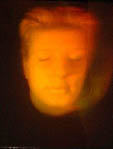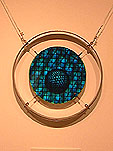Special Exhibition of work from the Jonathan Ross Hologram Collection at The Butler Institute of American Art, USA.

The Director and Board of Trustees of
The Butler Institute of American Art
invite you to the dedication of
The Beecher Center for Art and Technology of the Butler Institute of American Art
Friday, January 14,2000 7-9pm
Honoured Guest
Famed New York Times Cartoonist AL HIRSCHFELD
Special Guests
Artist PAUL JENKINS
Artist MICHAEL HARDESTY
International Art Collector JONATHAN ROSS
BEECHER CENTER INAUGURAL EXHIBITIONS
Nam June Paik: Electronic Superhighway Sponsored by Alltel
Art & Holography The Collection of Jonathan Ross, London, England
Graham Nash; Portraits Sponsored by Burger Travel Service
Michael Hardesty: Candle Blower 2
Also on View:
Al Hirschfeld: A Retrospective Sponsored by Attorney Michael Morley
Paul Jenkins: L'Eau at la Couleur Sponsored by Dr & Mrs Constantine G.Economus delicious hors d'oeuvres, decadent desserts cash bar reception sponsored by Alltel
flowers courtesy of Reese Floral Art programming in cooperation with PBS 45/49
The Butler's BEECHER CENTER, a south wing addition to The Butler Institute of American Art is a magnificent three story structure equipped with state-of-the-art capabilities for the creation and display of electronic art. With its skylit galleries, marble hallways, and high tech components, the Beecher Center ushers in a new era for American art and increases international visibility for "America's Museum".
Construction of the Butler's Beecher Center was initiated in conjunction with neighbouring Youngstown State University through a one time grant from the State of Ohio. The addition's completion was founded by individual regional donors and foundations.
Works shown:
1.
'Cornucopia', Margaret Benyon 1994/6
8"x10" reflection hologram. Computer morphed animation.

Two views from the animated image.
Margaret Benyon is one of the pioneer artists of holography and has been working with the medium since the 60s. Her work has gone through several distinct phases but this piece is unique in that it represents the only occasion on which she has used a computer to manipulate her imagery. It was first exhibited in 1996 in an exhibition of the same name, whose theme was 'Nature' .
2.
'Elevator', Caroline Palmer 1989
8"x10" reflection hologram. Multicolour.

Caroline Palmer's first holograms were exquisitely crafted reproductions of artifacts. Her 'Ancient Art Series' were the best examples of what one might consider classic holograms.
When the Royal College of Art offered her a place she went on to create a body of work exploring the possibilities of holography to render pure geometric forms and Tantric images. This piece is one panel of a triptych from her Degree Show.
3.
Study for 'The House of Moons', Susan Cowles 1988
8"x 10" reflection hologram.
Sue Cowles' holograms show the hand of the artist more than most as her images are generally constructed from drawings and paintings arranged in three dimensional space. This piece is a study for a larger work of which the full title is 'The House of Moons : A Stage for the Chymical Theatre'. Many of her themes refer to alchemy and the tarot.
4.
'Metamorphosis', Jeffrey Robb 1994
10"x8" reflection hologram. Computer morphed animation.
In 1993 I staged an exhibition of Jeffrey Robb's recent work entitled "Landscapes and Metamorphoses" one element of which was a beautiful series of very painterly holograms exploring the potential of holography to depict landscape. By contrast, the Metamorphoses were experiments at the interface of computers and holography utilising the recently developed morphing programs to manipulate appropriated images - in this case a photograph by Lee Friedlander.
5.
'Water Droplet', Jeffrey Robb 1994
4"x5" Animated reflection hologram.
One of the thrilling aspects of the holographic stereogram process, or multiplex hologram, is that it enables the artist to take any short sequence of film and create an animated hologram from it. This example shows how high-speed photography can be used and enables the viewer to play the sequence back and forth at will. The ripples created by the water droplet suggest to me the wavefronts of light used to create a hologram.
6.
'Kirsti', Pearl John 1992
10"x8" reflection. Reduced Image pulsed laser portrait.

Most pulsed portraits render their subject with a waxen clarity. By a simple intervention Pearl John has invested this image with an element of mystery and spirituality.
7.
'Inner Vision', Martin Richardson 1989
43cm x32cm reflection hologram. Reduced Image pulsed laser portrait.
A leading figure in British holography, the triangle became a signature symbol in Richardson's work during the 80's. In this self-portrait he uses it to represent the analytical process he was undergoing at the time.
8.
'Tigirl', Margaret Benyon 1985
13'x12" reflection hologram. Pulsed laser portrait with reproduction photograph.
In this self-portrait a double-pulse technique, commonly used in non-destructive testing, is used to create a tiger's stripes on the subject's face - interacting with the photograph of a tiger behind the hologram. The stripes are caused by the body's internal movements in the twenty billionth of a second between the two exposures. This piece prefigures Benyon's 'Cosmetic Series' in which painted images interact with holographic portraits.
9.
'Analytical Female', Martin Richardson 1989
40cm x 30cm reflection hologram. Multiple image.
Holography has the capacity to store an almost infinite number of images on one plate. In this example twenty four different shots of the same beautiful model are recorded in one hologram.
10.
'Arabesque', David Pizzanelli 1989
10"x8" mirror-backed white light transmission stereogram.
Pizzanelli's studies of photographic history led him to the realisation that Edweard Muybridge's working methods - the use of a succession of cameras to record a sequence of Human or Animal Locomotion - were similar to those used to create holographic stereograms. Making copies of Muybridge's originals in the V&A Museum in London, Pizzanelli was able to produce three-dimensional animated holograms of scenes first recorded over one hundred years ago.
11.
'Virtual Dialogues', Patrick Boyd 1993
5.5"x 6.25" nickel shim. Full colour holographic stereogram.
Better known for his laboriously hand made stereograms, Boyd had the use of Applied Holographics' state of the art equipment when he created this image for the cover of a magazine special on Virtual Reality. Inspired by a controversial Benetton advert featuring a newborn baby, he used his own son to illustrate the anxiety of a father for a child born into a world dominated by technology. Copies of the nickel shims (printing plates) used to mass replicate the image as embossed holograms were made as a limited edition .
12.
'Venus of Willendorf '91', Harriet Casdin-Silver 1991
180mm x 98mm nickel shim. Achromate holographic stereogram.
A limited edition copy of an image that appeared on the cover of ' Sculpture' magazine, this contemporary Venus recreates the famous prehistoric fertility symbol discovered in 1908. The proud model for the work, produced in collaboration with Hologram Industries in France, was a member of a collective devoted to promoting positive images of larger women. Casdin-Silver ,whose distinguished career dates back to the early days of holography, frequently focuses unflinchingly on the human body in her work. This untypically small piece, reminiscent of a Daguerreotype in material and clarity, is to my mind a miniature masterpiece.
13.
'Twin Towers', Patrick Boyd 1990
8"x10" achromate reflection hologram and photograph in box frame.
When first at the Royal College of Art, Boyd experimented with 'fashion holography', often collaborating with a make-up artist and stylist to create elaborately constructed Surrealist tableaux for the pulse laser. As an Artist in Residence at the Muse of Holography in New York he began to adopt a more documentary style, using a hand-held camera with a motor-drive to record sequences for holographic stereograms. This piece, featuring models dressed as the Statue of Liberty and the Empire State Building, represents a link-piece between the two styles.
14.
'Orgone Accelerator', Jon Mitton 1991
7" diameter circular reflection hologram.

Much of Mitton's work incorporates animation and optical effects - he worked for some time as a designer of light shows. This piece illustrates the alchemical power of holography, in the right hands , to transform simple ingredients into a magical, mesmerising,work of art.
15.
'Jackson Makes it to Manhattan', Patrick Boyd 1990
8"x10" achromate reflection hologram and photograph in box frame.
Boyd's innovative juxtaposition of still photography with animated holography typifies his individual approach to the medium. This piece is one of a series documenting his travels in North America. He has created similar bodies of work in Britain, Germany and Japan, distinguished by a humour unusual in holography and an original approach to display.
16.
'Homage to Louis Comfort Tiffany', Ruben Nunez 1978
8"x10'' mirror backed white light transmission hologram.

Attracted by the magical transforming powers of holography as much as by the complimentary nature of its relationship to glass sculpture, his primary medium, Nunez was one of the inspirational figures in the early days of art holography. This piece, one of the first I bought, has acquired a 'slightly foxed' look, probably due to the inadequate processing methods of the day, but has lost none of its original brilliance or poetry.
17.
'Hosepipes', John Kaufman 1980
4"x5" reflection hologram
Kaufman's work is noted for his original use of everyday objects and the way he employs holography to elevate them into radiant sculptural forms. Most of his images are at least 12"x16" but I have always regarded this piece as a little gem.
18.
'Lightman', Ken Harris 1981
8"x10" reflection hologram.

Harris was an 'American in London' when I first met him in the late '70s. Over three or four years he produced an interesting body of work characterised by the use of a Soviet developer which can transform essentially monochrome images into multicolour explosions such as this. This hologram has for me the sort of ecstasy-enducing qualities sought after by the artists who produced stained glass windows for cathedrals - a use to which I have always thought that holography would be well suited.
Please visit The Butler Institute of American Art web site.
http://www.butlerart.com/

